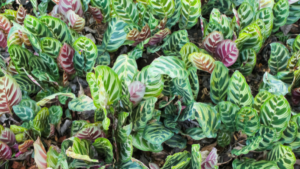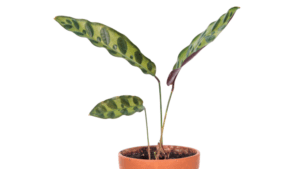Introduction

The Peacock plant known as Calathea belongs to the family Marantaceae. This family consists of several dozens of species and is native to Tropical Americas. The Peacock plant is a beautiful houseplant that is grown not for the flowers but for the attractive foliage. This plant is an excellent addition to indoor spaces, adding a touch of elegance and a tropical ambiance. Its unique foliage and relatively easy care requirements make it a popular choice for both beginner and experienced plant enthusiasts alike. Whether placed on a desk, shelf, or as part of a vibrant plant collection, the peacock plant is sure to captivate with its dazzling display of natural artistry.
The leaves of this plant are oval with a variety of marks including large and small blotches and dark green lines on a silvery green background. The patches on the upper surface of the leaves are relatively darker than the lower portions.
Other common name of these plants is the Prayer plant and Zebra plant. as these plants are tropical in origin and thus need heat and humidity and also shade from direct sunlight.
In the night the leaves of this plant fold together upwards like the human hands folded for the prayer.
Varieties
1. Calathea makoyana

It is a stunning tropical plant renowned for its eye-catching foliage. Native to the rainforests of Brazil, the peacock plant has become a popular choice among indoor plant enthusiasts worldwide.
With its vibrant and intricate leaf patterns, Calathea makoyana immediately captures attention. The oval-shaped leaves are characterized by their dark green color and striking feather-like patterns that resemble the captivating display of a peacock’s tail feathers. The patterns consist of various shades of green, accented with silver-green lines that create a mesmerizing effect. In addition to its ornamental value, the peacock plant is also known for its air-purifying qualities, helping to improve the quality of indoor environments.
Also known as Zebra plant. The leaves of this plant are beautifully marked in various shades of green, cream, white, pink, and silver held aloft on a maroon stem making it look like a peacock (1). This plant reaches a height of 18-24 inches and grows well under shade. The leaves are evergreen, pinnate, and spirally arranged.
2. Calathea insignis

This plant is also known as the Rattlesnake plant. It is a captivating tropical plant native to the rainforests of Brazil. Its distinct features include tapering narrow, erect foliage, yellow-green with lateral ovals. alternatively large and small with maroon underside (2).

Lance-shaped leaves with dark green coloration and contrasting patterns of wavy, light green stripes that resemble the skin of a rattlesnake. The undersides of the leaves showcase a beautiful reddish-purple hue. It thrives in bright, indirect light and high-humidity environments, making it an excellent choice for plant enthusiasts looking to bring a touch of the tropics into their homes.
How to propagate Calathea plant
Propagation of this plant is quite easy once they are properly established. As this plant rises from a single root and hence when the plant gets mature a clump of roots will form. When the clump gets overcrowded we can simply divide these plants. the most favorable season for this is the early spring. Divide the stock carefully so that some roots remain on each side.
As a low-maintenance plant, the peacock plant requires minimal pruning. However, removing any yellow or damaged leaves can help promote healthier growth. Fertilizing once a month during the growing season with a balanced houseplant fertilizer can provide the necessary nutrients.
Plant these plants in a potting mixture of moist compost and cover the rim of the pot with a plastic bag.
How to take care of Peacock or Calathea plant

1. Temperature
This plant needs bright indirect light or medium light with a temperature range between 18-30 degrees Celcius (65-85 degrees F).
2. Humidity
As this plant is tropical in origin thus requires high humidity with consistent moist and humid soil.
3. Light and position
Peacock plant prefers medium light under a tree or near a window.
4. Watering
Distilled or tap water is good for the growth of this plant. keeps the soil of this plant moist but never soggy. allow the top 2-3 inches to dry out before watering (2). As this plant needs high humidity therefore daily spraying is also good for the healthy growth of this plant.
5. Pest and insects
Red spider mite
This problem is because of the humidity. Watch for any yellow leaves of this plant. As these mites are almost invisible therefore it is advisable to cut the leave which is turning yellow.
Underwatering
As this plant loves humidity thus adds sufficient water.
Browning of the leaf tip
The foliage of the peacock plant dries up easily. Direct sunlight and a dry environment are the two major factors that make the plant turn brown, especially the leaf tips and the margins of the leaf. Keep your peacock plant out of direct sunlight and mist them daily.
